Birdsville is a small town and locality in the Shire of Diamantina, Queensland, it is located on land traditionally owned by the Wangkanguru People, in the Channel Country of Central West Queensland, Australia. It is 1,590 kilometres West of the state capital,
Brisbane, and 720 kilometres South of the city of
Mount Isa.
Birdsville is on the edge of the
Simpson Desert, approximately 174 km East of
Poeppel Corner.

Police Station and Court House, 1925
was known as Diamantina Crossing from 1881. There are a number of different theories as to the origin of the name. One is that the name derives from the prolific bird life in the district. The other is that a store was established by Percy Bird and George Field and they called it Birdfield. However, in 1882, G. and R. Wills, of
Adelaide, misaddressed a consignment of goods as going to
Birdsville and that name stuck. Another is that a man named Burt established a store and called it Burtsville which corrupted to
Birdsville. Whatever its origin, by 1882, the name
Birdsville was in common use and was formalised at the proclamation of town in 1887.

Birdsville Post Office 1926 with post box and hitching post

Birdsville Customs - Additions to Post Master and Sub Collector of Customs Residence Quarters - Floor Plan 1896
opened on 1 January 1883.
In 1885 there were plans to build a railway from
Hergott Springs (
Marree) to
Birdsville, a letter from August 1909 suggested it was impossible.

Hergott to Birdsville - proposed railway
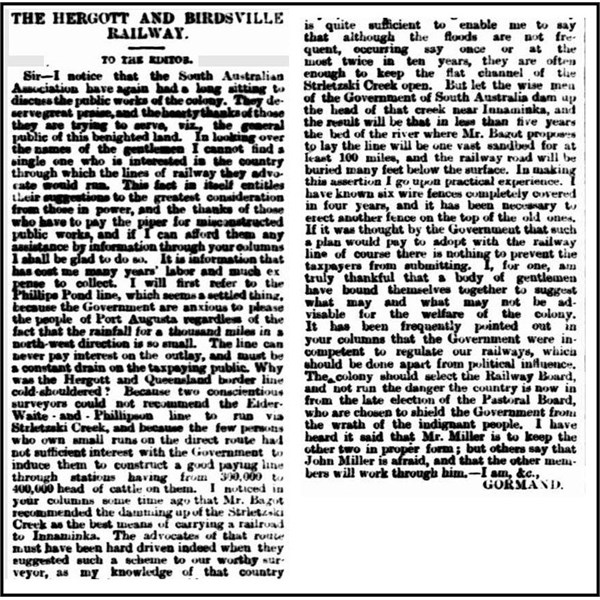
Hergott to Birdsville - proposed railway Adelaide Advertiser May 1885
was located at the border of South Australia and Queensland to collect tolls from the droves of cattle being moved interstate.
Many of Australia's pioneering European
explorers travelled through the
Birdsville district
well before the town was gazetted. Monuments to acknowledge the feats of Captain Charles Sturt, Burke and Wills, Cecil Madigan and others are located throughout the town.

E.A.COLSON - Crossing from Abminga to Birdsville Letter 1936 Part 1
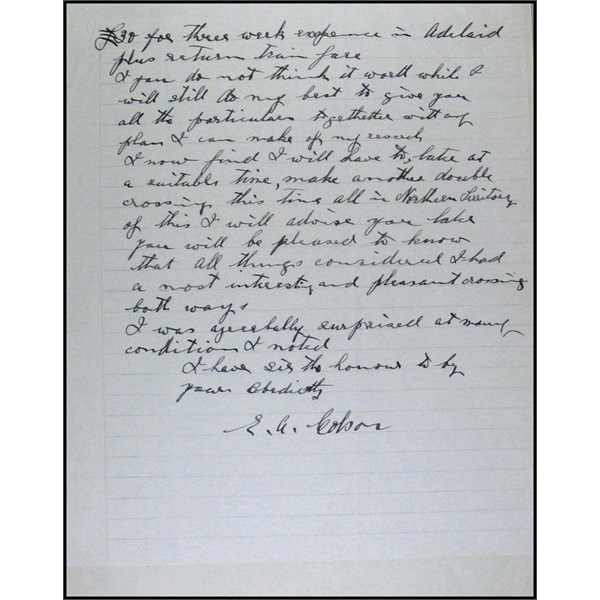
E.A.COLSON - Crossing from Abminga to Birdsville Letter 1936 Part 2
The first mail service was pioneered by Jack Hester in 1884 followed by a mail-passenger service opened in 1886 by August Helling using packhorses and buggy. From
Birdsville it was George Roberts' job to get the mail to Haddon Downs. He left
Birdsville on 27 December 1884 for the last time. His body was found near Nappanalka two weeks later. Sometimes the mail went by boat. In April 1887 the track between Cowarie Station and Goyder's Lagoon was flooded to such an extent that the only way to get the mail to
Birdsville was by boat. In 1902 it was Frank Booth who had the mail contract using a buggy and five horses. It was not until 1922 that the mail and some other supplies were delivered by car. Since 1970 the mail is carried by plane.

A rabbit fence inspector's outfit - H Chatterton, Superintendent of the Mitchell Rabbit Board, ready to start from Birdsville on a tour of inspection
In 1890 it was suspected that Mr Helling, or his driver, was also involved in Sly-grog selling, although this was never proved. This practice was quite common. Eating houses which operated at Clayton, Blazes
Well, New
Well, Mungerannie and Mulka were all suspected of illegally supplying alcohol. Very few cases have been proven and even fewer convictions made.
The best known mail man along the track was Esmond Gerald (Tom) Kruse, MBE, of 'Back of Beyond Fame' who delivered the mail for nearly twenty years, come drought, 'hell or high water'. Over the years mail, stores and passengers have been dropped off at
Lake Harry, Clayton, Dulkaninna, Cannuwaukaninna, Mona Downs Tidnacoordooninna, Etadunna, Kopperamanna, Killalpaninna, New
Well, Mulka, Oorawillanie, Mungerannie, Blazes
Well, Appatoongoonie, Cowarie, Kalamurina,
Mitta Mitta, Mount Gason, (named after
police trooper and later publican Samuel Gason) Minnie Downs, Karratunga, Alton Downs, Mays Hills, Clifton Hills,
Pandie Pandie, Andrewilla, Diamantina and
Birdsville.

Mail contractors loading mail at Birdsville for the Birdsville to Marree Mail Service 1950-56
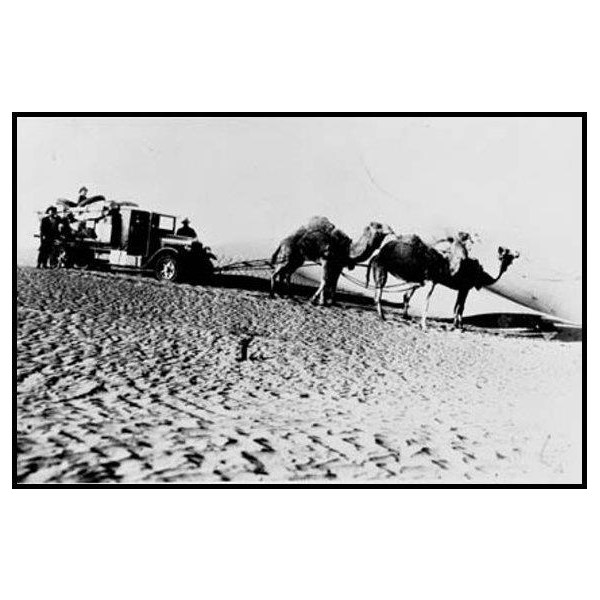
Help from camels on the Maree-Birdsville mail
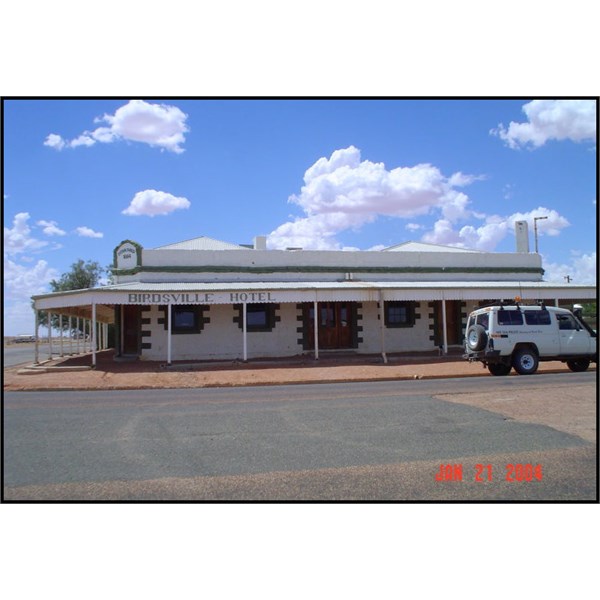
Birdsville Hotel
is a
heritage-listed hotel at Burt Street,
Birdsville, Shire of Diamantina, Queensland, Australia. It was built c.?1884. It was added to the Queensland
Heritage Register on 21 October 1992. The singled-storeyed
sandstone building was erected c.?1884 as the
Birdsville Hotel,
Birdsville, for publican William Blair. The earliest section of the
Birdsville Hotel is likely to have been constructed in 1883 (possibly from stone quarried at a site about 16 kilometres from the town), as the first license for this hotel was issued to William Blair in that year. On the official
Birdsville town survey plan of mid-1885, the building is marked as Wm Blair's hotel. On 24 February 1886, Blair purchased from the Crown, for £206, the allotment at the corner of
Adelaide and Burt streets which contained the hotel. A month earlier he had bought for £12 the allotment at the rear, which contained a fenced yard and had frontages to Burt & Graham streets; also an unimproved allotment adjacent to this, fronting Graham Street, for £8. Each block comprised 2 roods.
Following Blair's death in 1898, title to all three blocks passed to Queensland Trustees (Charles H Morton was the licensee during this period), then to the Hayden family in 1912, the Gaffney family in 1918, and the Dixon family in 1947. The building continues to function as a hotel, and has become nationally famous. With its longevity, romantic remoteness, and as a focus for festivities associated with the annual
Birdsville Races, the
Birdsville Hotel has become an outback icon.
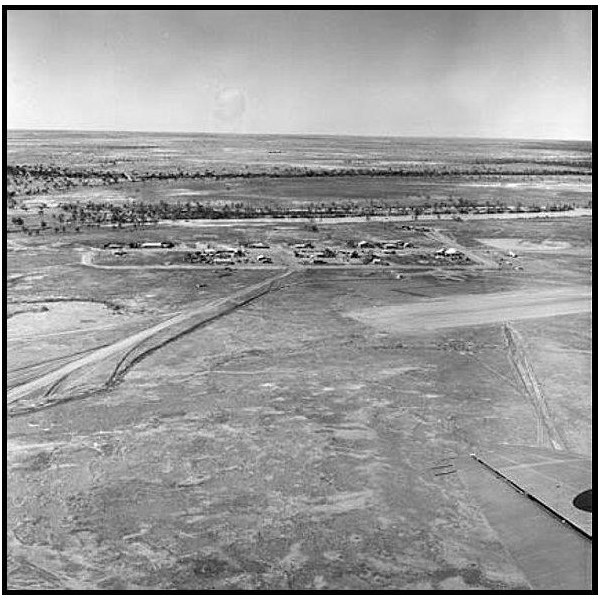
Aerial view of Birdsville 1966
It is understood that in 1905 a storm destroyed all of the structures on the site other than those constructed in stone. In 1964 the southeast corner of the building collapsed, also as a result of the storm. This section was reconstructed c.?1990-91, although not to original detail. A fire destroyed the front bar, also in 1964; this has been rebuilt. The major changes to the building have been the replacement of the front verandah, additions to the northern end, and reconstruction of the southeast section. Internally, no original finishes appear to exist as the floors have been laid in slate, walls plastered and painted, and ceilings altered. The building however retains its essential character.
Birdsville had a
population of over 300 at the turn of the twentieth century. It had three hotels, a cordial factory, blacksmith store, market gardens,
police and customs facilities but after Federation in 1901, the tolls were abolished and the town fell into decline to about 50 people throughout the 1950s. Livestock trade kept the region alive and in recent times tourism has joined cattle as the major industry in the area.

Police Station and Court House, 1925
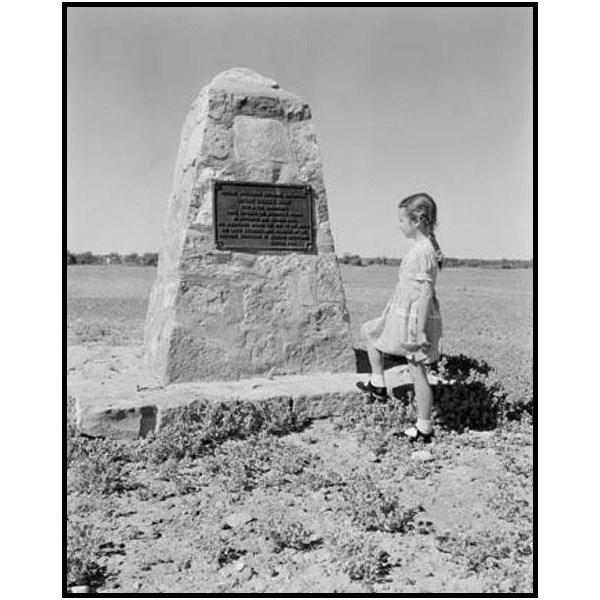
Memorial to Captain Charles Sturt, Birdsville 1956
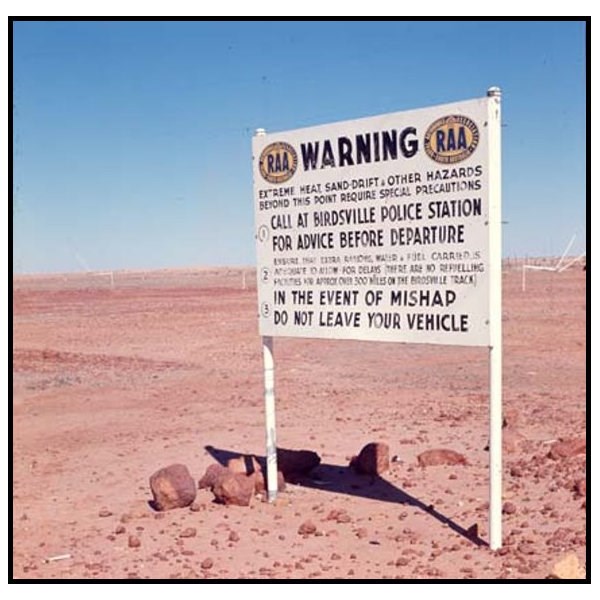
warning sign on Birdsville track